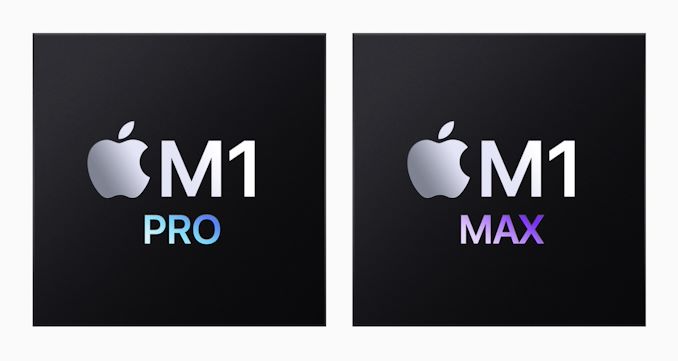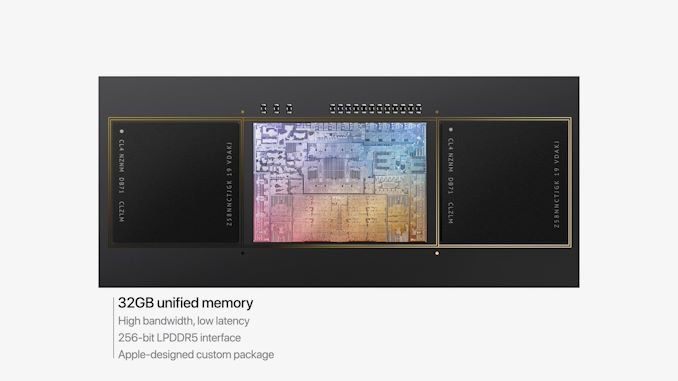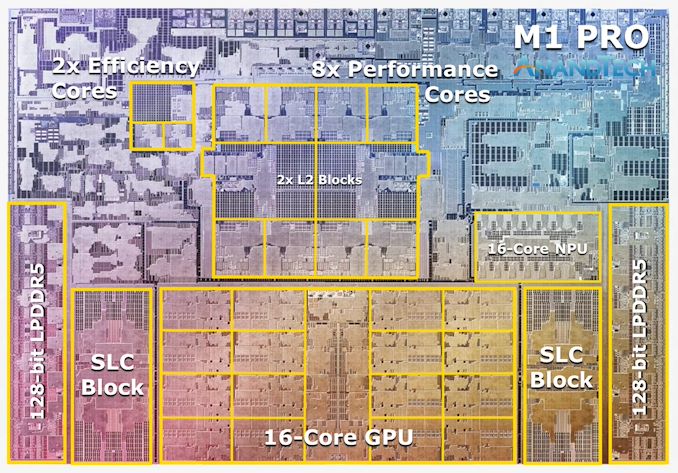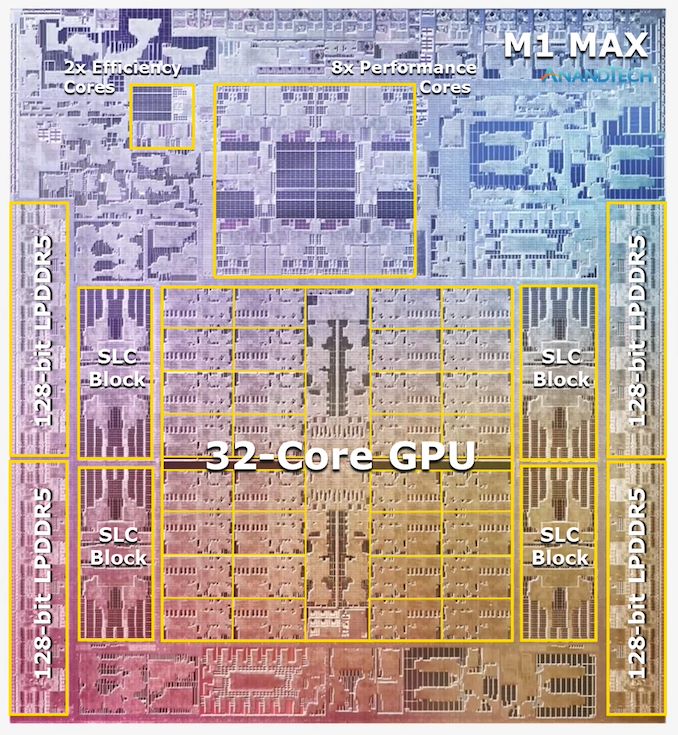Apple's M1 Pro, M1 Max SoCs Investigated: New Performance and Efficiency Heights
by Andrei Frumusanu on October 25, 2021 9:00 AM EST- Posted in
- Laptops
- Apple
- MacBook
- Apple M1 Pro
- Apple M1 Max

Last week, Apple had unveiled their new generation MacBook Pro laptop series, a new range of flagship devices that bring with them significant updates to the company’s professional and power-user oriented user-base. The new devices particularly differentiate themselves in that they’re now powered by two new additional entries in Apple’s own silicon line-up, the M1 Pro and the M1 Max. We’ve covered the initial reveal in last week’s overview article of the two new chips, and today we’re getting the first glimpses of the performance we’re expected to see off the new silicon.
The M1 Pro: 10-core CPU, 16-core GPU, 33.7bn Transistors
Starting off with the M1 Pro, the smaller sibling of the two, the design appears to be a new implementation of the first generation M1 chip, but this time designed from the ground up to scale up larger and to more performance. The M1 Pro in our view is the more interesting of the two designs, as it offers mostly everything that power users will deem generationally important in terms of upgrades.
At the heart of the SoC we find a new 10-core CPU setup, in a 8+2 configuration, with there being 8 performance Firestorm cores and 2 efficiency Icestorm cores. We had indicated in our initial coverage that it appears that Apple’s new M1 Pro and Max chips is using a similar, if not the same generation CPU IP as on the M1, rather than updating things to the newer generation cores that are being used in the A15. We seemingly can confirm this, as we’re seeing no apparent changes in the cores compared to what we’ve discovered on the M1 chips.
The CPU cores clock up to 3228MHz peak, however vary in frequency depending on how many cores are active within a cluster, clocking down to 3132 at 2, and 3036 MHz at 3 and 4 cores active. I say “per cluster”, because the 8 performance cores in the M1 Pro and M1 Max are indeed consisting of two 4-core clusters, both with their own 12MB L2 caches, and each being able to clock their CPUs independently from each other, so it’s actually possible to have four active cores in one cluster at 3036MHz and one active core in the other cluster running at 3.23GHz.
The two E-cores in the system clock at up to 2064MHz, and as opposed to the M1, there’s only two of them this time around, however, Apple still gives them their full 4MB of L2 cache, same as on the M1 and A-derivative chips.
One large feature of both chips is their much-increased memory bandwidth and interfaces – the M1 Pro features 256-bit LPDDR5 memory at 6400MT/s speeds, corresponding to 204GB/s bandwidth. This is significantly higher than the M1 at 68GB/s, and also generally higher than competitor laptop platforms which still rely on 128-bit interfaces.
We’ve been able to identify the “SLC”, or system level cache as we call it, to be falling in at 24MB for the M1 Pro, and 48MB on the M1 Max, a bit smaller than what we initially speculated, but makes sense given the SRAM die area – representing a 50% increase over the per-block SLC on the M1.
The M1 Max: A 32-Core GPU Monstrosity at 57bn Transistors
Above the M1 Pro we have Apple’s second new M1 chip, the M1 Max. The M1 Max is essentially identical to the M1 Pro in terms of architecture and in many of its functional blocks – but what sets the Max apart is that Apple has equipped it with much larger GPU and media encode/decode complexes. Overall, Apple has doubled the number of GPU cores and media blocks, giving the M1 Max virtually twice the GPU and media performance.
The GPU and memory interfaces of the chip are by far the most differentiated aspects of the chip, instead of a 16-core GPU, Apple doubles things up to a 32-core unit. On the M1 Max which we tested for today, the GPU is running at up to 1296MHz - quite fast for what we consider mobile IP, but still significantly slower than what we’ve seen from the conventional PC and console space where GPUs now can run up to around 2.5GHz.
Apple also doubles up on the memory interfaces, using a whopping 512-bit wide LPDDR5 memory subsystem – unheard of in an SoC and even rare amongst historical discrete GPU designs. This gives the chip a massive 408GB/s of bandwidth – how this bandwidth is accessible to the various IP blocks on the chip is one of the things we’ll be investigating today.
The memory controller caches are at 48MB in this chip, allowing for theoretically amplified memory bandwidth for various SoC blocks as well as reducing off-chip DRAM traffic, thus also reducing power and energy usage of the chip.
Apple’s die shot of the M1 Max was a bit weird initially in that we weren’t sure if it actually represents physical reality – especially on the bottom part of the chip we had noted that there appears to be a doubled up NPU – something Apple doesn’t officially disclose. A doubled up media engine makes sense as that’s part of the features of the chip, however until we can get a third-party die shot to confirm that this is indeed how the chip looks like, we’ll refrain from speculating further in this regard.














493 Comments
View All Comments
sthambi - Wednesday, November 3, 2021 - link
Hi Anand, I stumbled across your blog post, and I enjoyed reading it. I'm a professional video editor, photographer. Ordered the 32 core, 64GB, M1 Pro Max for $3900. I'm upgrading from the iMac 5k, late 2015 model. I personally feel like am overkilling my configuration. I don't want to look back 2 years from now, and feel like I lost 4k, and now apple doubled again. Do you think I really need this much heavy configuration to use premiere pro cc, max 5k video editing, and canon raw images, and simultaneous creative cloud application running? what would you recommend, which can help me save money and not compromise on the performance? is my decision of going full configuration bad?MykeM - Sunday, November 14, 2021 - link
Read the byline (the names under the headlines). The site’s namesake- Anand- left a few years ago. He no longer writes here. The people replacing him are every bit as capable but none of them are actually named Anand.razer555 - Thursday, November 4, 2021 - link
https://www.youtube.com/watch?v=OMgCsvcMIaQhttps://www.youtube.com/watch?v=mN8ve8Hp4I4
Anandtech, your tests about the graphic seems wrong.
Sheepshot - Sunday, November 7, 2021 - link
Anand tech = Apple shills.M1 beats both the M1Pro and max in power efficiency. Draws 50% of watt butt provides almost 65-70% of the performance in most relevant benches.
Hrunga_Zmuda - Sunday, November 7, 2021 - link
Shills?The 90s called and want your insult back.
evernessince - Wednesday, November 10, 2021 - link
HWUB just did a review of the M1 pro in actual applications and performance is good but not nearly as impressive as Anand suggests. These chips are competitive with laptop chips but you certainly don't need to bust out server class components as suggested in the article. Performance is very good in certain areas and in others it's very poor. Most of the time it's about as good as X86 laptop chips. GPU is decent but given the price, you can get much much more performance on X86 at a much lower price.Motti.shneor - Sunday, November 14, 2021 - link
I think I heard M1 Max and M1 Pro have different number of CPU cores? Here you say they're identical?Also, I keep asking myself why a tech visionary like yourself doesn't see the "big picture" and the bold transitional step in computing taken here.
For me, that sheer "horse power" means very little - I'm using a 1st generation M1 Mac-Mini, with medium configuration, beside an i9 MacBookPro from 2020 - and the Mini is SO MUCH BETTER in each and every way and meaning (except of course for the terrible bugs and deteriorating quality and bad behavior at boot time, the EFI and such)
As a power user, and Mac/iOS software engineer/tech-lead for over 35 years, and with my pack of 400 applications installed, some native, some emulated, and my 0.5TB library of photos and 0.5TB library of music.... well, with all this, I can testify that MacMini "feels" 5 times faster than the MBP, in most everything I DO. Maybe it'll fail on benchmarks, but I couldn't care less. Rebuild a project? snap. Export a video while rescaling it? Immediate! heavy image conversion? no time. Launch a heavy app? before you know it. It FEELS very very fast, and that's 1st generation.
What I think IS IMPRTANT and not being said by anyone, is that the whole mode of computing goes back from "general purpose" into "specialized hardware". You can no longer appreciate a computer by its linear-programming CPU cycles, and if you do - you just get a completely wrong evaluation.
Moreover - you CANT just "port some general C code from somewhere" and expect it to run fast. You MUST be using system APIs at SOME LEVEL, that will dispatch your work onto specialized hardware, so you gain from all those monstrous engines under the hood. If you will just compile some neural-networks engine or drag it over in python or something, it'll crawl and it will suck. But if you use Vision Framework from Apple, you'll have jaw-dropping performance. You MUST build software FOR the M1, to have the software shine. This is a paradigm shift, that contradicts everything we've seen in the last 40 years (moving from custom hardware into general-purpose computing devices).
If history is to repeat itself like so many times in the past - soon enough all the competitors in the Computing arena will be forced into similar changes, so not to lose market share - and we'll have a very strange market, much harder to compare - because the Apple guys will always bring in Apple software highly optimized to use the hardware, and the "other" guys will pull their "specialized" software for their special processors... I
I am quite thrilled, and I really want to have one of them M1 Max machines, just to feel them a little.
Despite the long threads underneath, I think Gaming is not even secondary in the list of important aspects - And I also predict that Game makers will skip the Mac in the future just like today. It's not because they don't like it, but because of tradition, and because of the high priced entry point of Powerful Mac computers. Still - Corporate-America is buying MBPs like mad, and they'll keep doing that in the coming 3-5 years.
stevenLu - Tuesday, December 7, 2021 - link
I am a fan of Apple technology. And I am only glad to read news about their development and some new technologies. Another new technology is used by Lucid Reality Labs. You can read more on their website https://lucidrealitylabs.com/blog/5-vr-headsets-ma...Cloakstar - Tuesday, December 21, 2021 - link
One reason this M1 Max performs so well is that even though the CPU is in control, the memory hierarchy is more GPU+CPU than the typical CPU+GPU, so the typical APU memory bottleneck is gone. :D AMD APUs, for example, are highly memory bound, doubling in performance when you go form 1 stick of RAM to 4 sticks with bank+channel interleaving.wr3@k0n - Friday, December 24, 2021 - link
For a $3499 no shit it's competing with server grade, if it comes with that price. Though PC still ends up being cheaper and infinitely more repairable and upgradeable. This article doesn't address many of the drawbacks of the Apple ecosystem and it will take more than "close to PC" performance.